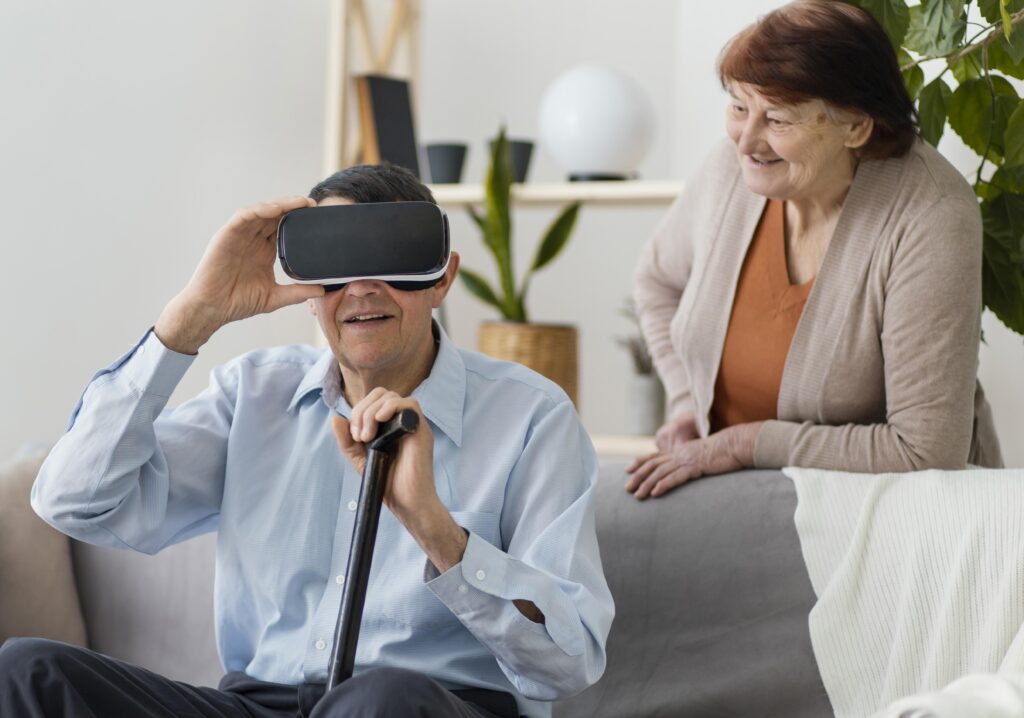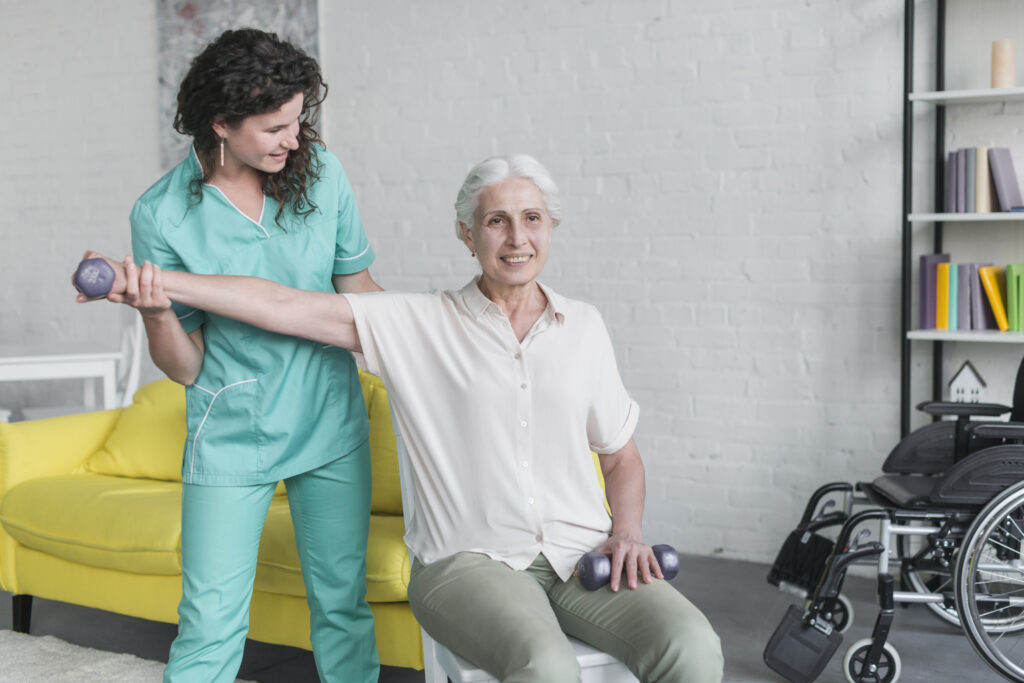Aging brings new physical challenges—but AR for senior rehabilitation is changing how older adults heal. Through interactive technology and personalized therapy, augmented reality (AR) is revolutionizing recovery for seniors. In this post, you’ll discover how AR makes rehab more engaging, precise, and effective—helping seniors regain mobility, confidence, and independence.

What Is AR and Why It Matters in Senior Rehabilitation
Augmented reality (AR) is a technology that overlays digital information—like visuals, sounds, and data—onto the real world using devices such as smartphones, tablets, or AR glasses. Unlike virtual reality, which creates an entirely separate environment, AR enhances your current surroundings.
For seniors undergoing rehabilitation, AR provides a new way to interact with their environment through guided exercises, real-time feedback, and gamified therapy tasks. AR for senior rehabilitation bridges the gap between clinical care and accessible, home-based therapy.
Why AR for Senior Rehabilitation Is a Breakthrough
1. Boosts Engagement and Compliance
Many seniors find traditional rehab exercises repetitive. AR introduces gamified elements, transforming physical therapy into enjoyable tasks. When seniors enjoy their rehab, they’re far more likely to stay consistent—leading to better outcomes.
2. Delivers Real-Time Feedback
Modern AR rehab platforms use motion sensors and cameras to track body movements and provide instant feedback. This allows for accurate exercise execution and minimizes injury risk.
3. Adapts to Individual Needs
AR-based therapy plans can be customized to suit each person’s mobility level, progress speed, and physical condition. Whether recovering from a stroke or a joint replacement, therapy becomes tailored and smarter.
4. Supports At-Home Rehabilitation
Accessibility is a game-changer. AR for senior rehabilitation doesn’t require a clinic—many platforms work on tablets or phones. Seniors can receive care in the comfort of their home while therapists monitor their progress remotely.
5. Improves Cognitive Function and Mood
Many AR programs include memory tasks, pattern recognition, or timed activities that challenge the brain. These tools promote not only physical recovery but mental sharpness and emotional well-being—especially for seniors at risk of isolation or cognitive decline.
Real-Life Uses of AR in Elderly Rehab
AR for senior rehabilitation is already being applied in various real-world scenarios:
- Stroke Recovery – Programs like Neuro Rehab VR help patients relearn movement and coordination.
- Joint Replacement Rehab – AR guides seniors through post-surgery mobility exercises for hips and knees.
- Balance & Fall Prevention – Tools like ARBalance provide engaging balance training, improving coordination and confidence.
- Parkinson’s Disease Support – AR visual prompts can help those with Parkinson’s overcome movement blockages and practice gait exercises.
How AR Compares to Traditional Rehabilitation
| Feature | Traditional Rehab | AR for Senior Rehabilitation |
| Engagement | Often repetitive | Interactive, game-like |
| Feedback | Therapist-dependent | Real-time, instant corrections |
| Personalization | Therapist input needed | Software adapts on-the-fly |
| Accessibility | In-clinic only | Home-based and remote-ready |
| Motivation | Can decrease over time | High due to interactive elements |
Key Considerations for Using AR in Senior Therapy
Before implementing AR for senior rehabilitation, here are a few things to consider:
- Ease of Use: Choose AR platforms designed with senior-friendly interfaces.
- Professional Oversight: AR should complement, not replace, guidance from a licensed therapist.
- Tech Barriers: Not all seniors are comfortable with technology; caregivers may need to assist.
- Initial Cost: While long-term savings are possible, some AR systems may require upfront investment.
Tips for Caregivers and Healthcare Providers
To ensure success with AR rehab:
- Start Slowly: Introduce the platform with short sessions to build confidence.
- Stay Involved: Monitor usage and offer support during sessions.
- Track Progress: Use built-in analytics or therapist reports to review improvements.
- Choose Evidence-Based Tools: Only use AR tools with proven therapeutic value.
What’s Next for AR in Elder Care?

The future of AR for senior rehabilitation looks bright:
- AI Integration for deeper personalization
- Voice-Guided AR for visually impaired seniors
- Wearable AR for passive rehab monitoring
- Social Connectivity to reduce isolation via multiplayer rehab tasks
As the technology evolves, the barrier to entry will fall, making AR more accessible for older adults and caregivers alike.
READ MORE
Are you ready to ensure your loved ones receive the best care at home? Stay informed and join our community support forum to receive the latest tips on elder care:
Final Thoughts: AR as a Lifeline for Senior Recovery
AR for senior rehabilitation is no longer a futuristic idea—it’s a real, accessible, and effective approach to elder care. Whether used to boost motivation, enable at-home therapy, or enhance accuracy, AR is changing how we support aging adults in their journey to recovery.
By integrating engaging digital experiences with real-world therapy, AR empowers seniors to heal faster, live more independently, and enjoy a better quality of life.
Disclaimer
The information provided in this blog post is for educational and informational purposes only and is not intended as a substitute for professional medical advice, diagnosis, or treatment. Always seek the advice of your physician, physical therapist, or other qualified health provider with any questions you may have regarding a medical condition or rehabilitation program.
Use of this information is at your own risk. The author and publisher disclaim any liability for injury, loss, or damages resulting from the use or application of any content presented in this article.
Always, to my Beloved Parents:
Everyday-
I think of you
I miss you
I Love You ❤️

Recent Comments